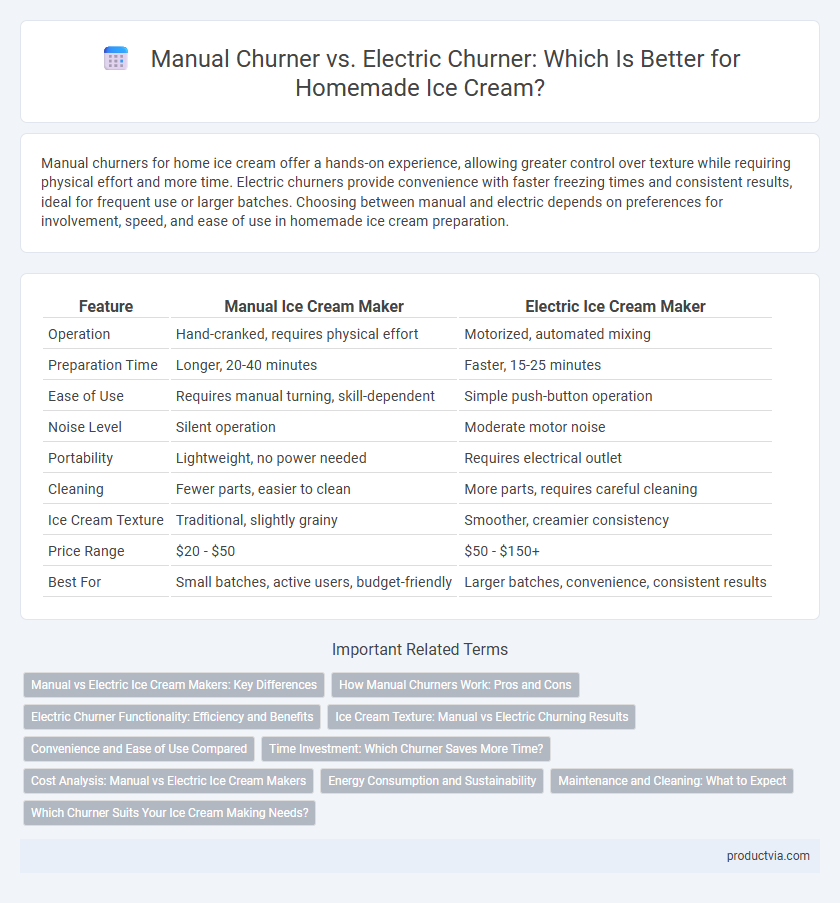Manual churners for home ice cream offer a hands-on experience, allowing greater control over texture while requiring physical effort and more time. Electric churners provide convenience with faster freezing times and consistent results, ideal for frequent use or larger batches. Choosing between manual and electric depends on preferences for involvement, speed, and ease of use in homemade ice cream preparation.
Table of Comparison
| Feature | Manual Ice Cream Maker | Electric Ice Cream Maker |
|---|---|---|
| Operation | Hand-cranked, requires physical effort | Motorized, automated mixing |
| Preparation Time | Longer, 20-40 minutes | Faster, 15-25 minutes |
| Ease of Use | Requires manual turning, skill-dependent | Simple push-button operation |
| Noise Level | Silent operation | Moderate motor noise |
| Portability | Lightweight, no power needed | Requires electrical outlet |
| Cleaning | Fewer parts, easier to clean | More parts, requires careful cleaning |
| Ice Cream Texture | Traditional, slightly grainy | Smoother, creamier consistency |
| Price Range | $20 - $50 | $50 - $150+ |
| Best For | Small batches, active users, budget-friendly | Larger batches, convenience, consistent results |
Manual vs Electric Ice Cream Makers: Key Differences
Manual ice cream makers require physical effort to churn the mixture, offering a hands-on experience and greater control over texture, but they typically take longer to freeze the ice cream. Electric ice cream makers automate the churning process with motors, providing consistent results faster and often with built-in refrigeration, ideal for convenience and frequent use. Choosing between manual vs electric ice cream makers depends on preferences for ease of use, speed, and level of involvement in the ice cream-making process.
How Manual Churners Work: Pros and Cons
Manual churners operate by turning a hand crank that rotates the ice cream mixture inside a container, allowing gradual freezing and incorporation of air for a creamy texture. They offer advantages such as low cost, portability, and no need for electricity, making them ideal for outdoor use or small batches. However, the process is labor-intensive and time-consuming, and achieving consistent texture can be challenging compared to electric churners.
Electric Churner Functionality: Efficiency and Benefits
Electric ice cream churners offer superior efficiency by maintaining a consistent churning speed and temperature control, resulting in smoother and creamier ice cream textures. Their automated motor reduces manual effort and churn time, allowing for larger batch sizes and more precise ingredient incorporation. These features enhance overall convenience and enable more consistent, high-quality homemade ice cream compared to manual churners.
Ice Cream Texture: Manual vs Electric Churning Results
Manual churners produce a denser, creamier ice cream texture by incorporating less air and allowing slower freezing, resulting in a rich, homemade consistency. Electric churners rapidly churn the mixture, introducing more air and creating a lighter, softer texture similar to commercial ice cream. Choosing between manual and electric churners depends on desired texture preferences and willingness to engage in hands-on preparation.
Convenience and Ease of Use Compared
Manual ice cream churners require physical effort and more time, making them less convenient for quick preparation but ideal for hands-on control and traditional methods. Electric ice cream churners offer significant ease of use with automated mixing and faster freezing times, enhancing convenience for busy households. Home users often prefer electric models for their user-friendly features and consistent results.
Time Investment: Which Churner Saves More Time?
Electric ice cream churners significantly reduce the time required to make ice cream at home, typically completing the churning process in 20 to 40 minutes, compared to manual churners that can take 45 minutes to over an hour. Manual churners demand continuous physical effort and attention, which can slow down the process and increase overall time spent. Choosing an electric churner optimizes efficiency and minimizes time investment, ideal for those seeking quicker homemade ice cream results.
Cost Analysis: Manual vs Electric Ice Cream Makers
Manual ice cream makers generally have a lower upfront cost and require no electricity, making them an economical choice for budget-conscious homeowners. Electric ice cream makers, while more expensive initially, offer faster freezing times and consistent texture, potentially saving money on energy bills in the long term due to efficient motor operation. Considering maintenance expenses, manual churners incur minimal costs, whereas electric models may require occasional repairs or part replacements, affecting overall cost analysis.
Energy Consumption and Sustainability
Manual ice cream churners require no electricity, making them the most energy-efficient and sustainable option for home use. Electric ice cream makers consume varying amounts of energy, with low-wattage models designed to minimize electricity use and environmental impact. Choosing a manual churner reduces carbon footprint by eliminating power consumption, while electric models offer convenience at the cost of increased energy use.
Maintenance and Cleaning: What to Expect
Manual ice cream churners require minimal maintenance and are easy to clean with simple hand washing of the churn and paddles. Electric churners often have removable parts designed for dishwasher safety but need careful attention to the motor and electrical components to prevent damage. Regular cleaning and drying after each use help prolong the lifespan of both manual and electric ice cream makers.
Which Churner Suits Your Ice Cream Making Needs?
Manual churners offer hands-on control and a traditional ice cream making experience, ideal for small batches and users who enjoy the process. Electric churners provide convenience with automated mixing and faster freezing times, suitable for frequent use and larger quantities. Choosing between manual and electric churners depends on your commitment to the craft, batch size preferences, and desired ease of use.
Manual churner vs electric churner for home ice cream Infographic

 productvia.com
productvia.com